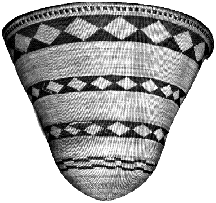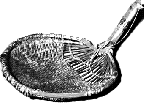
Back to Main Page
Gift/Storage Basket. Ht. 30"; Dia. 25". 
Seedbeater. Using the seedbeater, edible wild seeds were harvested by knocking seeds off the plant and into the burden basket. Typical length: 20".
 Seedbeater. Length 20"
Seedbeater. Length 20"
Acorn and Seed Meal Winnowing, "Sifting" Baskets, and Trays. "Sifting," winnowing baskets, and trays are round or triangular. The baskets are deep while the trays are shallow or flat. Close-twined round or triangular "sifters" were used to separate fine, fully-ground acorn meal from the coarser meal which required additional pounding. Seeds were also sifted with these basketry implements. The fine meal was separated by a side-to-side shaking action. Both closed- and open-weave baskets and trays were used for winnowing. Typical dia.: 20".
Deep
Sifting Basket. Dia. 20".
Openwork Winnowing Basket. Dia. 20"
Triangular Basket. Length 20".
Mortar and Pestle. Acorns were the staple food source of the California Indians. These nuts were pounded into meal on stone mortars. The funnel-shaped mortar baskets, with a hole at the bottom, were used to concentrate the meal in the bottm of the basket onto the mortar rock. This prevented the meal from flying off the mortar during pounding. Typical dia. across the top: 14".
Mortar Basket. Dia. 14".
Mortar Basket and Pestle. Dia. 14".
Large Gift/Storage Basket from North Central California. Dia. 30".
Large Storage Basket from Northwestern California. Dia. 30".
Food Serving Tray. Dia. 20".
Large Cooking Basket. Dia. 24".
Large
Cooking Basket. Dia. 24"
Food Serving Platters. In many parts of northern California, openwork twined platters were used to serve roasted fish or meat. Typical dia.: 12-15".
Food Platter. Dia. 15".
Food Serving Baskets. Small coiled or twined gift baskets with flaring sides were used for individual servings of acorn soup or mush, and for dipping and pouring water. Typical dia. across mouth: 3" to 6".
Small Serving Basket. Dia. 6".
Shell Basket. Dia. 7".
Lidded "Trinket" Baskets were a post-contact innovation in northwestern California. They were made primarily for sale to European collectors. Typical dia.: 6".
Basketry Tobacco Pouches were also made in northwestern California. Typical dia.: 3".
Gambling Trays, shallow, round woven basketry were used by women while playing gambling games. Typical dia.: 20".
Tobacco Pouch. Dia. 6".
Gambling Tray. Dia. 20".
Lidded Trinket Basket. Dia. 6".
Elliptical Basket. Length 5-30".
Treasured Gift Baskets. The Pomo tribes are famous for their elaborately decorated coiled-baskets used as gifts to store small valuables. Such "treasure" baskets were (and are) more valuable than the items stored in them. The baskets are decorated with beads or feathers. Sometimes they are completely covered with red woodpecker feathers ("sun" baskets), or with a combination of brightly colored feathers. The feathers were tightly stitched into the basket weave. Such valuable baskets were presented as gifts to friends as well as for wedding gifts. They are also used as sacrifical item when a person who owned the basket dies. These elaborate baskets are also made for sale to collectors. Typical dia.: 7".
Feather Basket. Dia. 7".
Sun
Basket. Dia. 7".
Miniature Baskets displayed the basketweaver's skill. They were given as a gift or sold, and sometimes were used in doctoring ceremonies. Typical dia.: 1/4" - 2".
Miniature Basket. Dia. 1/4" - 2" .
Basketry Water Bottle. Dia. 10".
Basketry Cradle. Basketry cradles were used by all northern California tribes. The baby was fastened into the cradle which was carried on the mother's back. Typical length is 30" although a variety of sizes were made to correspond to the age of the infant.
Basketry Cradle. Length 30".
Basketry Cap. Basketry caps were worn in the northwest and areas of eastern California. Plain, everyday caps were worn by both men and women. Fancy dress-up caps of the finest quality twined weave are still made and worn by the women today. Typical dia.: 8".
Basketry Cap. Dia. 8".
Basketry Moccasins. Some tribes also used basketry techniques to weave foot-gear or moccasins out of tule rushes or other plant materials.
Basketry moccasins. Length 10".
Invaginated Fish Trap. Dia. 18".
Fish Trap. Dia. 12".
Woodpecker Trap. Dia. 4".
Coiling. A flexible rod, or cluster of 3 rods, is coiled and continuously bound to the preceding level. This method produces a strong but quite stiff basket or tray.
Coiling.
Simple Open-Work Twining is used for traps and some winnowing trays. As in cloth weaving, a horizontal weft goes under and over the vertical warp. Two or three pieces of horizontal weft material may also be twisted around each other.
Simple Open-Work Twining.
Tightly Woven Twining. This weave is used for cooking baskets, caps, water bottles, and for other items where waterproofing is required, or where flexibility is essential. The weaving includes a variety of complex and difficult techniques and designs.
Tightly Woven Twining.